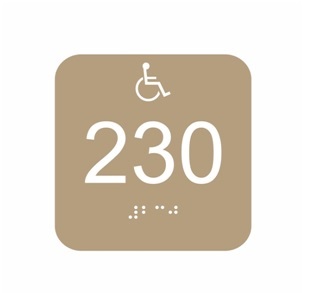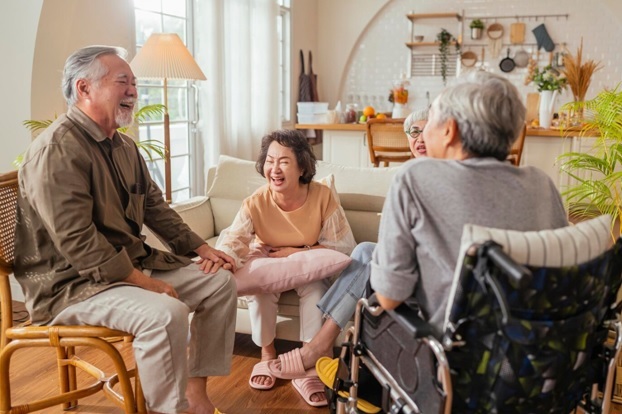Elderly Care Facilities: The Role of Room Number Signs with Braille in Assisted Living Spaces
Entering an elderly care facility can be an emotional journey for many families. The mix of hope and anxiety often both hang in the air. It's a place where residents, each with their unique stories and needs, call home. The goal is to make their lives as comfortable and safe as possible.
This is where the importance of Braille signs becomes evident. These seemingly simple signs play a pivotal role in ensuring that elderly residents, especially those with visual impairments, can find their way around with ease and confidence.
Challenges of Visual Impairment
Visual impairment is a common challenge among the elderly. Conditions like age-related macular degeneration, cataracts, and glaucoma become more prevalent with age. These impairments make it difficult for seniors to read small print, recognize faces, or navigate unfamiliar environments.
In the context of elderly care facilities, visual impairment poses unique challenges. Residents may struggle to find their rooms, identify common areas, or read important notices. This not only causes frustration but also affects their safety and quality of life.
The Importance of Accessibility
This is why accessibility in elderly care facilities is not merely a matter of convenience; it's a matter of dignity and well-being. Ensuring that these facilities are accessible is crucial for the physical and emotional health of their residents.
Accessibility empowers elderly individuals by enabling them to maintain their independence and participate in activities of daily living. It also helps to create an environment that fosters a sense of belonging and inclusion, reducing the risk of social isolation.
The Silent Significance of Braille
For most of us, finding our room in a hotel or a hospital is a routine task. We look for the room number, and it's often right there, on a sign.
However, for seniors who may have limited vision or visual impairments, this task can be daunting. Just imagine arriving at a new place, where each corridor seems like a labyrinth, and every door looks the same. This is where Braille room number signs become not just signs but lifelines for residents in elderly care facilities.
For the Families: Picture the reassurance a family feels when they know their loved ones can independently find their way in the facility, no matter how simple it may seem. It's about providing dignity and autonomy to the seniors, who often struggle with the changes that come with aging.
The Features That Matter in Room Number Signs with Braille
Let's dive into the features that make Braille room number signs indispensable in elderly care facilities:
1. Tactile Information
The inclusion of Braille characters alongside printed room numbers ensures that residents with visual impairments can easily identify their rooms by touch. These tactile characters are placed beneath the visual room numbers, allowing residents to feel their way around.
For example, let’s say an elderly resident with visual impairment arrives at their new room. With the tips of their fingers, they feel the Braille characters below the room number. This immediate feedback assures them that they're in the right place.
2. High Contrast
Braille room number signs often feature high-contrast color combinations. This is crucial, as many seniors experience age-related vision changes. The high contrast makes the text more legible and allows residents with limited vision to discern the signs more easily.
An elderly resident with cataracts or low vision, for example, is better able to approach a room number sign where the bold, high-contrast colors make the room number stand out, even from a distance.
3. Durable Material
In the bustling environment of an elderly care facility, room number signs are subject to frequent touch and potential wear. Quality Braille signs are crafted from durable materials that withstand the test of time, maintaining their legibility and usability.
The signs in a busy corridor, for instance, are exposed to daily handling. Quality material ensures the Braille characters stay intact and legible, helping residents without interruption.
The Impact on Elderly Residents
The benefits of room number signs with Braille in elderly care facilities are evident from the moment a resident arrives. Here's how these signs impact the lives of elderly residents:
1. Independence and Confidence
For seniors, especially those with visual impairments, finding their room independently is a significant achievement. The presence of Braille room number signs empowers residents to navigate the facility with a sense of autonomy and confidence.
An elderly resident that is no longer dependent on staff or fellow residents to find their room will be able to confidently move around, enhancing their self-esteem, and even allowing the staff to spend more time and energy on other matters that may need their attention.
2. Reduced Stress
Transitions can be stressful for the elderly. When they can effortlessly find their room, the stress associated with adapting to a new environment diminishes. It offers a smooth transition and eases the emotional burden on residents.
A senior who recently moved into the facility, for example, might feel more at ease if they don't have to worry about getting lost or feeling disoriented.
3. Safety and Well-Being
Apart from room identification, room number signs with Braille play a crucial role in emergency situations. They ensure that elderly residents can quickly locate their rooms in case of evacuation, enhancing safety and well-being.
In an emergency, time is of the essence. Braille room number signs facilitate swift room identification, especially if the emergency has created limited vision, ensuring the safety of all residents.
Equip Your Facility with Proper Room Number Signs with Braille
Braille room number signs in elderly care facilities are not just signs but also symbols of compassion. These unassuming signs can make a world of difference in the lives of elderly residents, enhancing their independence, safety, and overall well-being.
Braille room number signs silently advocate for the dignity of seniors, helping them find their way in this new phase of life. And it's this silent advocacy that can bring gratitude to their families, knowing their loved ones are in a place that genuinely cares.
At Braille Sign Pros, we understand the significance of these signs. We create Braille room number signs that reflect our commitment to ensuring the comfort and accessibility of elderly care facilities. It's more than a sign; it's a message of respect and inclusivity.







Comments
Post a Comment